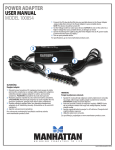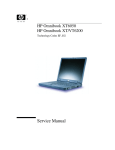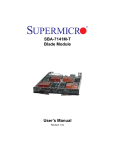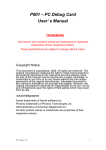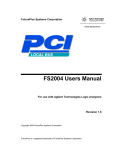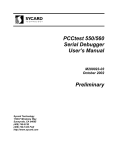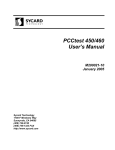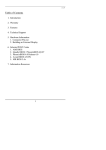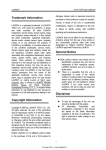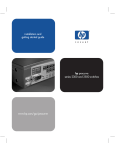Download Service Manual
Transcript
3 Troubleshooting and Diagnostics This chapter includes troubleshooting and diagnostic information for testing the functionality of the notebook, and for identifying faulty components: • ASP support information • Troubleshooting information • ! Checking for customer abuse (page 3-3). ! Troubleshooting the problem (page 3-3). ! Verifying the repair (page 3-4). ! Suggestions for troubleshooting (page 3-5). Diagnostic tools ! e-Diagtools diagnostic program (page 3-18). ! Power-on self-test (page 3-19). ! Sycard PCCtest 450/460 PC card (page 3-25). ! Windows Management Instrumentation (page 3-26). ! BIOS Setup utility (page 3-26). Support by Authorized Service Providers In the U.S., support of notebook computers by Authorized Service Providers (ASPs) is a purchasable option. Standard predefined models and standard special models do not include ASP support. The sales force has the option of creating models with ASP support using the specials process. The serial number label on the bottom of the notebook indicates the ASP support status for that model. See the following table. Table 3-1. ASP Support Options Serial Number Label “NoASP” “ASP” ASP Support Status No reimbursement to ASP for parts or labor. However the ASP is authorized to repair the notebook, and reimbursement can be negotiated directly with the customer. Parts and labor will be reimbursed to the ASP. In other countries, ASP support is standard in most situations—but you should check the marking on the serial number label to verify the ASP support status for that model. Service Manual Troubleshooting and Diagnostics 3-1 Troubleshooting The suggestions in this section can help isolate and repair the cause of a problem. To ensure quality repair, follow the basic troubleshooting steps shown below. Check the customer’s description of the problem and any supporting information. Check for customer abuse. Try to duplicate the customer’s problem. Troubleshoot the problem using: - Diagnostic tools. - Troubleshooting suggestions. Verify the repair by testing the functionality of the complete unit. Figure 3-1. Basic Troubleshooting Steps 3-2 Troubleshooting and Diagnostics Service Manual Checking for Customer Abuse Some notebooks might appear to have been damaged by customer abuse. Use these guidelines to help determine if this is the case: • If the shipping box is seriously damaged, customer abuse cannot be declared. • If the damage could have a cause other than customer abuse, customer abuse cannot be declared. • If the notebook shows any of the following, customer abuse is declared: ! Missing parts. ! Broken plastic parts. ! Parts not original to the notebook. ! Damaged or missing keys on the keyboard. Table 3-3 lists additional criteria for determining customer abuse to specific parts of the notebook. Important Parts damaged by customer abuse are not covered by the warranty. Troubleshooting the Problem Record pertinent information about the notebook: • Model and serial number. • Operating system and version. • Software version (stored in hidden file c:\version.inf). • BIOS version. • Accessories and peripherals used. Analyze the problem: • Observe Symptoms. Using the customer’s information, try to duplicate the problem. Determine how the problem differs from proper behavior. Also, note the functions that do work properly. • Separate Problems. If there are multiple symptoms, separate them into distinct problems. • Consider Causes. Keep in mind possible causes for each problem. Use the diagnostic tools and troubleshooting suggestions to help find possible causes. ! ! The e-Diagtools diagnostic program tests most of the notebook’s components using automatic and interactive tests, and is your primary troubleshooting tool. Other tools include the power-on self-test, WMI/Toptools (if installed), the BIOS Setup utility, and the Sycard PCCtest. Table 3-2 on page 3-5 shows how you can use these tools to isolate the cause of the notebook’s problem. The troubleshooting suggestions on page 3-6 include general suggestions for repairing notebooks that show specific failure symptoms. Service Manual Troubleshooting and Diagnostics 3-3 Swapping modules that might be defective with others known to be good is generally an ideal way to find the module responsible for the problem. A failure symptom is rarely caused by more than one module, so you will not usually need to replace more than one to correct a particular failure. After you replace a module, the notebook will normally be in a confused state and lock up when you apply power. If this happens, press the reset button: this turns the notebook off, so that you can restart it in a known state. Verifying the Repair Before returning the repaired notebook to the customer, verify the repair by running the following tests: • e-Diagtools Basic Diagnostic Test. Run the basic test of the e-Diagtools diagnostic program (page 3-18). –and– • Function Tests. Run tests that check the repaired function, such as those in e-Diagtools (page 3-18). –and– • 3-4 Failed Tests. Run any other tests that failed during troubleshooting. Troubleshooting and Diagnostics Service Manual Suggestions for Troubleshooting Table 3-2. Scope of Diagnostic Tools Function Bootup Processor Memory Fan Batteries e-Diagtools Tests Tests Power-On Self-Test Tests Tests Tests Tests (CMOS battery only) Sycard PCCtest 450 WMI/ Toptools (if installed) Describes Describes Describes Describes Describes Tests Describes Display Tests Tests Describes Hard disk Tests* Tests Describes Floppy drive Tests Tests Describes Keyboard Tests Audio Tests* Describes Serial Tests Describes Parallel Tests Describes LAN Modem Wireless Describes Infrared Tests† PS/2 port Describes USB Port replicator Tests Tests Describes PCMCIA Tests IEEE 1394 Status AC adapter * Test might be available only on certain units. † Use an external keyboard to exercise the port. Run the external 101-key test. Service Manual BIOS Setup Configures Configures Configures Configures Configures Configures Configures Configures Configures Configures Configures Configures Troubleshooting and Diagnostics 3-5 If you cannot isolate the cause of a problem using the above diagnostic tools, use the suggestions in the following table to help find the problem. Table 3-3. Troubleshooting Suggestions Symptom Call Center: Suggestions Repair Center: Likely Causes Repair Center: Comments To help determine likely causes of a problem, determine which replaceable modules are involved in the system function and what roles they play: see the figure on page 1-27 and the table on page 1-28. Startup Does not boot on AC or battery. Beeps once, spins hard disk, repeats, but does not boot. Does not boot on battery, but boots on AC. Does not boot from floppy drive. Does not boot from CD in CD/DVD drive. 3-6 Check power source. Press and hold power button to turn notebook off, then press power button to turn notebook on. Unplug AC adapter, remove the battery and any PC cards, press reset button to turn notebook off, then reconnect power and try again. Do not use touch pad while booting or resuming. Remove all but one SDRAM module and try again. Reinsert any other SDRAM module and try again. AC adapter. SDRAM module. CPU module. Switchboard PCA. Motherboard. Display assembly. Hard drive. Make sure at least one SDRAM module is installed. SDRAM module. Make sure battery is properly installed and fully charged. Check battery level on battery LEDs. Check battery contacts. If available, try another battery. Make sure floppy disk is bootable. Use BIOS Setup to check default boot order. Make sure CD is bootable. Use BIOS Setup to check default boot order. Restart notebook. Battery or contacts. Motherboard. Troubleshooting and Diagnostics Check AC adapter. Remove all but one SDRAM module and try again. If power status light does not turn on, reprogram BIOS, replace top case, replace motherboard. If power status light turns on but display remains off, try external monitor. If monitor shows successful boot, replace display assembly. If monitor shows activity but BIOS does not complete, replace display assembly. If monitor is blank, replace switchboard PCA, replace motherboard. If power status light and display turn on, BIOS completes, but OS does not start from hard disk or floppy drive, replace CPU module, replace motherboard. If OS starts from floppy drive, reload hard drive, replace hard drive. Floppy disk or floppy drive. Motherboard. Make sure floppy drive is installed and connected correctly. CD/DVD drive. Motherboard. Make sure CD/DVD is installed and connected correctly. Service Manual Symptom Sluggish startup or shutdown. Error message such as “Invalid system disk” or “Auto IDE error”. Password forgotten. Power No power. Service Manual Call Center: Suggestions Use Tools tab in disk’s Properties sheet to check hard disk. Use Disk Defragmenter to optimize hard disk. Delete temporary and unneeded files. Check for disk in floppy drive. Check boot order in BIOS Setup. Remove and reinstall hard drive. Repair Center: Likely Causes Hard drive. Repair Center: Comments Hard drive contacts. Hard drive. If notebook boots from floppy drive, check for corrupt files on hard drive, use Recovery CDs to reinstall factory software onto hard drive, replace hard drive. User must call Technical Support and provide proof of ownership. Password removal is restricted to certain sites. See page 5-1. Verify proper ownership, then follow removal procedure with owner and record appropriate data—see page 5-1. Make sure charged battery is installed or AC adapter connected. Try another battery or AC adapter if available. AC adapter. Battery. Motherboard. Troubleshooting and Diagnostics 3-7 Symptom Notebook has short operating time when on battery. Turns off immediately after turning on. Does not run on battery; empty battery indication. Beeps repeatedly. Battery does not charge. 3-8 Call Center: Suggestions Turn down display brightness. Check timeout settings in Power in Control Panel. Check power management settings in BIOS Setup. Try default settings. Battery gauge might need calibration. Run HP Battery Optimizer from Start menu. Certain applications can cause excess CPU and power usage. (User can get Intel Power Monitor from www.intel.com and monitor CPU load.) When playing DVD movies on battery power, use Power Options in Control Panel to select Portable/Laptop power scheme. When using applications with automatic save feature (such as MS Word), extend save time or disable to reduce hard disk access and power usage. PCMCIA card use can affect battery life. Some PCMCIA cards draw power even while not in use. Heavy modem use can affect battery operating time. Battery may be extremely low. Plug in AC adapter or insert charged battery Check battery and contacts. Try another battery if available. Notebook beeps repeatedly when battery is low. Connect AC adapter or replace battery. Make sure AC adapter has correct power rating. Make sure AC adapter is connected properly and battery installed properly. Check battery contacts. If available, try another battery and AC adapter. Move notebook away from any nearby heat source. Unplug AC adapter and allow battery to cool. Check for blocked air vents. Troubleshooting and Diagnostics Repair Center: Likely Causes Battery. Motherboard. Repair Center: Comments Battery capacity often decreases after a year or more. Battery. Battery or contacts. Motherboard. Battery. Battery or contacts. AC adapter. Motherboard. Heatsink. Check battery and AC adapter. Check heatsink. Service Manual Symptom AC adapter does not power notebook. Battery indicator is inaccurate. Standby/resume General problems. Notebook resumes slowly from Standby mode. Does not suspend to Standby mode as expected. Does not automatically enter Hibernation mode as expected. Service Manual Call Center: Suggestions Try another AC adapter, if available. Repair Center: Likely Causes AC adapter. Motherboard. Repair Center: Comments AC adapter cannot be repaired, and must be replaced. Time Remaining is an estimate based on notebook’s power use at that moment. It therefore depends on current task, and assumes power will be used at that rate until battery runs out. So if notebook is currently using good deal of power (such as when reading CD or DVD), Time Remaining likely shows less time than actually remains. Close all applications before entering (or allowing notebook to enter) Standby or Hibernation mode. If problem appears after installing new software (including drivers), uninstall that software. Contact software vendor for additional support. Notebook can take a minute or longer to resume if network card is installed. Blinking cursor appears while system is loading and checking hardware and network connections. When hardware is reinitialized, Windows desktop appears. Notebook won’t suspend if connection to another computer is active. If notebook is busy, it normally finishes current operation before suspending. Make sure hibernate support is enabled in Power in Control Panel. Also, make sure Hibernate timeouts (Power Schemes tab) for AC and battery power are not set to Never. Troubleshooting and Diagnostics 3-9 Symptom Display Dark display, no light. White display. Call Center: Suggestions Repair Center: Likely Causes Repair Center: Comments Make sure notebook is turned on and warmed up. Check power supply. Make sure SDRAM modules are installed properly. Adjust display brightness. Press Fn+F5 several times. Try external monitor. Display cable connection. SDRAM modules. CPU module. Display assembly. Motherboard. Check cable connections. Replace SDRAM modules. Make sure CPU module is installed properly, replace CPU module. Check display cable connections, replace display assembly. If external monitor displays no image, replace motherboard. Adjust display brightness. Display assembly. Switchboard PCA. Display cable connection. Switchboard PCA. Display assembly. Motherboard. Display cable connection. Display assembly. Erratic display. Bright or missing pixels or lines. See quality statement on page 5-2. Punctured display. Vertical crack near center of display. Scratched display glass. Local area of dark or light discoloration visible when display is on. External display does not work. Hard disk Hard disk never spins. Hard disk makes clunking or scratching noise. Hard disk makes buzzing or whining noise. 3-10 Usually caused by closing display with pencil-sized object on keyboard. Caused by excessive pressure applied to area on screen. Check connections. Press Fn+F5 several times. Try display on another computer. External display. Motherboard. Check power source. Remove and reinstall hard drive. Check connector. Back up disk immediately. Was notebook or drive dropped? Back up disk immediately. Check hard disk installation. Check for alternate noise sources, such as PCMCIA drive or fan. Hard drive or connector. Motherboard. Hard drive. Troubleshooting and Diagnostics Check display cable connection. Check display cable connection. See quality statement on page 5-2. Declared to be caused by customer abuse. Declared to be caused by customer abuse. Declared to be caused by customer abuse. Declared to be caused by customer abuse. If drive case is damaged, drive may not operate properly. Check notebook and drive for evidence of customer abuse. Depends on noise source. Service Manual Symptom Files corrupted. Disk capacity less than normal. Disk’s reported capacity is less than actual size Floppy drive General problems. CD/DVD drive Particular CD or DVD not playing properly. Cannot read any CD or DVD. DVD movie stops playing. Service Manual Call Center: Suggestions Run virus scan program. Check hard disk using Tools tab in disk’s Properties sheet. Test hard disk drive with e-Diagtools diagnostics. Back up files if possible, then use Recovery CDs to reformat hard disk and reinstall factory software. Check hard disk using Tools tab in disk’s Properties sheet. Check partitions using Control Panel, Administrative Tools, Computer Management under Storage. Use Recovery CDs to reformat hard disk and reinstall factory software. Hard disk allocates approximately 20 MB to diagnostic software. This space is unavailable for other uses, and not included in hard disk capacity reported by Windows. No response from floppy drive. Check disk for proper insertion, dirt, or damage. Clean with soft cloth or replace as needed. If CD was created on CD-RW drive, try using HP certified media. Read and write quality can vary for other media. Restart notebook. Make sure CD/DVD drive is installed properly. DVD may be double-sided. Movie may be paused. Press Play button. Repair Center: Likely Causes Repair Center: Comments Hard drive. Floppy drive. Motherboard. Make sure floppy drive is installed and connected correctly. CD/DVD drive. Troubleshooting and Diagnostics 3-11 Symptom Region Code error. “System Error: Unable to read drive” message. No DVD or CD-RW software on notebook. All DVD play is erratic. Keyboard Some or all keys do not work properly. Embedded numeric keypad does not work. PS/2 keyboard and mouse with Y-adapter do not work. 3-12 Call Center: Suggestions DVDs contain embedded regional codes that prevent them from playing outside region in which they are sold. This error occurs when trying to play DVD intended for different region. Important: Most DVD drives allow region code to be changed only a limited number of times (usually no more than four). When this limit is reached, last change is hard-coded on DVD drive, and is permanent. Refer to DVD player software help for details. Make sure disk is clean, undamaged, and inserted correctly. Clean with soft cloth or replace as needed. Wait 5 to 10 seconds after closing tray before pressing Play. Restart notebook. If software was removed, use the Recovery CDs to reinstall factory software. Some DVDs include software called “PC Friendly”. This software can cause errors or erratic play. If needed, uninstall PC Friendly and restart notebook. Check settings in Control Panel. Press Fn+F8 to activate numeric keypad, and Lock key to turn on number lock. Avoid touching touch pad while booting or resuming. Check devices separately. Troubleshooting and Diagnostics Repair Center: Likely Causes Repair Center: Comments HP warranty does not cover expense of correcting this situation. CD/DVD drive. Motherboard. Make sure CD/DVD drive is installed properly. Keyboard. Motherboard. Keyboard. Motherboard. Try reinserting ribbon cable in connector on motherboard. Y-adapter. PS/2 device. Motherboard. Service Manual Symptom Touch pad General problems. Special touch pad features not working. Call Center: Suggestions Repair Center: Likely Causes Reset notebook (see page 1-21). Check settings in Control Panel. Make sure touch pad is enabled in Mouse Properties. By default, touch pad is disabled if external PS/2 mouse is connected, Use BIOS Setup to check settings. Avoid touching touch pad while booting or resuming. In Mouse Properties, select Synaptics PS/2 TouchPad driver. (Driver is installed from \hp\drivers\touchpad.) Top case. Motherboard. Click button does not work. Memory Out of memory error. Notebook does not boot after adding SDRAM. Audio No sound audible. Sound does not record. Service Manual Repair Center: Comments Top case. Motherboard. Top case. Motherboard. Make sure C drive has adequate free space. Delete temporary and unneeded files. Use memory troubleshooter in Windows Help. Not all third-party memory cards have been tested for use with notebook. Use only DDR-266 SDRAM modules. SDRAM module. Increase sound volume. Check whether sound is enabled (mute button and software controls). Check for sound resource conflicts in Device Manager. Test audio with e-Diagtools diagnostics. Use an external microphone (internal microphone normally not included). Check software controls. Test audio with e-Diagtools diagnostics. Top case. Speaker assembly. Switchboard PCA. Motherboard. SDRAM module. Check operation using headphones or external speakers (switchboard PCA). Make sure speaker assembly cable is connected. Switchboard PCA. Motherboard. Troubleshooting and Diagnostics 3-13 Symptom Serial/Parallel/USB General problems. Modem General problems. 3-14 Call Center: Suggestions Repair Center: Likely Causes Check connections. Restart notebook. Use troubleshooters in Windows Help. Check settings in Control Panel. Check port settings in Device Manager. Test ports with e-Diagtools diagnostics. For USB: contact device vendor and HP Notebook Web site (see page vi) for latest USB drivers. For USB: if the device is powered by the USB port, try the other port. Motherboard. Check settings in Control Panel. Open hardware Device Manager. If modem is disabled, try to enable. If modem has a conflict, try disabling another device. Use analog telephone line (2, 3, or 4 wires), not PBX or digital line. In a hotel, ask for data line. Try disabling error correction and data compression. Test modem with e-Diagtools diagnostics. Motherboard. Troubleshooting and Diagnostics Repair Center: Comments Service Manual Symptom LAN/network General problems. Infrared General problems. Service Manual Call Center: Suggestions Repair Center: Likely Causes Check cables and connections. Try connecting notebook to another network station (if applicable). If green light next to LAN port does not light, LAN cable may not be connected to network or network may be down. Use networking troubleshooter in Windows Help. Check settings in Control Panel. Make sure LAN cable is Category 3, 4, or 5 for 10Base-T operation, or Category 5 for 100Base-TX operation. Maximum cable length is 100 meters (330 feet). Test LAN with e-Diagtools diagnostics. Motherboard. Infrared is disabled and no drivers installed as shipped. (Drivers are included.) Make sure line between infrared ports is not blocked, ports face each other squarely and are no more than 1 meter apart. Sunlight, heat from nearby equipment, or other sources of infrared radiation can cause transmission errors. Open Hardware Device Manager. Try to enable the infrared port. Remove any PC cards from notebook (possible IRQ conflict). For fast-IrDA, check for DMA conflict with ECP parallel port. Motherboard. Repair Center: Comments Troubleshooting and Diagnostics 3-15 Symptom Wireless General problems. One-Touch button problems Buttons not working properly. On-screen display does not appear when button is pressed. PCMCIA General problems. AC adapter Does not power notebook. Motherboard Evidence of spilled liquid. Bent or broken connectors, or burnt component. Motherboard cracked. Miscellaneous Clock loses time Notebook gets abnormally hot. 3-16 Call Center: Suggestions Repair Center: Likely Causes Repair Center: Comments Check TCP/IP setup in Control Panel. Check SSID, channel, and encryption settings. Mini-PCI card. Antenna PCAs. Motherboard. Make sure all cables are properly connected to miniPCI card and motherboard. Check for damaged coaxial cables or connectors. Make sure correct applications are associated with buttons in One-Touch tab of Keyboard in Control Panel. Make sure Onscreen Display is enabled in One-Touch tab of Keyboard in Control Panel. Keyboard cover. Switchboard PCA. Motherboard. Restart notebook. Try card in another computer. If card requires an IRQ, make sure one is available. In Device Manager, refresh device list and check for conflicts. Download current drivers from card manufacturer’s Web site. PCMCIA socket. Motherboard. Using a flashlight, look for bent pins inside the PCMCIA socket. For model XE4500, if only one slot is affected, replace PCMCIA socket. If both slots are affected, replace motherboard. Make sure AC adapter has correct power rating. Try another AC adapter, if available. AC adapter. Motherboard. AC adapter cannot be repaired and must be replaced. Declared to be caused by customer abuse. Declared to be caused by customer abuse. Declared to be caused by customer abuse. Plug in AC adapter for 24 hours to charge CMOS battery. Always set notebook on a flat surface, so air can flow freely around and underneath it Make sure air vents are not blocked. Games and other programs that drive CPU usage toward 100% can contribute. Troubleshooting and Diagnostics CMOS battery. Motherboard. Charge CMOS battery. Heatsink. Check heatsink for damage or proper fan operation. Check thermal contact between CPU and heatsink. Replace thermal pad if needed. Service Manual Symptom Notebook pauses or runs sluggishly. Notebook still on but stops responding. Accessories Port replicator problems. Service Manual Call Center: Suggestions May be normal Windows behavior (background processing can affect response time). Certain operations (such as virus scanning or file browsers) can affect performance. Press Ctrl+Alt+Del to see if an application is not responding. Restart notebook. If hard disk has spun down to conserve power, it can take several seconds to spin up (you can hear this). Use Control Panel to modify hard disk power settings. Check for overheating—see previous symptom. If notebook’s hard drive frequently runs (as indicated by hard drive light on front of notebook) while notebook appears to be paused or running slowly, consider installing additional SDRAM. Make sure hard drive has adequate free space. Delete temporary and unneeded files. Press Ctrl+Alt+Del and end any application not responding. Reset notebook (see page 1-21). Repair Center: Likely Causes CPU module. Motherboard. Repair Center: Comments If notebook slows after period of continuous activity, check heatsink—see previous symptom. Check notebook’s power supply. Check settings in BIOS Setup. Port replicator. Motherboard. Port replicator is not repairable, and must be exchanged. Troubleshooting and Diagnostics 3-17 Diagnostic Tools This section describes the following diagnostic tools you can use for troubleshooting and repairing the notebook: • Notebook e-Diagtools diagnostic program (below). • Power-on self-test (page 3-19). • Sycard PCCtest 450 PC card (page 3-25). • Windows Management Instrumentation (page 3-26). • BIOS Setup utility (page 3-26). e-Diagtools Diagnostic Program The hardware diagnostic programs provide two levels of testing: • User-level testing using a basic hardware test. • Advanced testing using individual hardware tests. The tests are designed to run after the system reboots, so that the notebook will be in a predictable state during the tests. The tests are non-destructive, and are intended to preserve the state of the notebook. The notebook reboots when you exit the program so drivers can be loaded. Updating e-Diagtools You can download the latest version of e-Diagtools using e-Diagtools for Windows. Running e-Diagtools The following procedure describes how to run e-Diagtools. The individual steps might differ slightly for different versions of e-Diagtools. 1. Click Start > Turn Off Computer (or Shut Down), Restart. 2. When the HP logo appears, press F10 to start the diagnostic test. The first time you run the program, you are prompted to select the language for the program. 3. When the menu appears, press F2 to run e-Diagtools. 4. When the Configuration Description appears, check the list of detected hardware. 5. Run the basic test. Press F2 to start the basic hardware test. The results appear when the test is complete. 6. If you intend to exit without running the advanced tests, press F4 to view the Support Ticket. Press F3 to exit e-Diagtools. 7. Optional: run the advanced tests. Press F2 to open the advanced test screen. 8. Use the arrow keys and ENTER to select the test you want to run. Tests are listed only for detected hardware. 9. Press F2 to run the selected tests and add the results to the Support Ticket. 3-18 Troubleshooting and Diagnostics Service Manual 10. After each run, press F2 to return to the advanced test screen, or press F4 to view the Support Ticket. 11. Exit. Press F3 and then any key to exit and reboot. 12. Optional: open the Support Ticket. In Windows, click Start > All Programs (or Programs) > Hewlett-Packard > Notebook > HP e-Diagtools > e-Diagtools for Windows. 13. Click View to display the Support Ticket. 14. To add information about your problem, click Comments, type the information, and then click OK. To save or print the Support Ticket, click Save As or Print. To e-mail the Support Ticket to your support agent, click e-Mail. The first time you make an email connection from this program, click Change Settings in the Connect window and enter the settings recommended by your support agent. e-Diagtools for Windows can also update the version of e-Diagtools on your notebook’s hard disk. In e-Diagtools for Windows, use the e-Diagtools menu. If you have trouble running e-Diagtools diagnostics from the hard disk, you can also run it from the Recovery CD or DVD. Boot from the CD or DVD and select the diagnostics option. Interpreting the Results The e-Diagtools diagnostic program returns test groups, error codes, and suggestions for repair and/or follow-up actions. The basic hardware test shows a recommended replacement part. To help interpret the results of the e-Diagtools tests, refer to the following: • e-Diagtools Support Ticket on page 3-19. • Replaceable Module Diagram on page 1-27 • Functional Structure Description on page 1-28 This combined information should enable you to determine which of the notebook’s components require service. Power-On Self-Test Note If Quiet Boot is enabled in BIOS Setup (the default setting), press Esc during boot to see POST messages. When the notebook boots, its system BIOS runs a series of initialization routines and diagnostic tests called POST (Power-On Self-Test). The BIOS will not boot the notebook’s operating system if the system memory, CPU, DMA, or interrupt controller fails the POST diagnostic tests. POST indicates progress by a sequence of codes; if an error occurs, the BIOS displays a message and/or issues a beep code. Note that not all POST messages indicate a failure in the notebook—some messages are for information only. You should not necessarily interpret the failure of one or more POST tests as a hardware, software, or firmware failure. If POST displays an error message or issues a beep code indicating an error, confirm the problem using other diagnostic tools. Service Manual Troubleshooting and Diagnostics 3-19 First, confirm the failure by performing a “clean” boot, as described below. Note that if the notebook fails to restart with a clean boot, it requires repair. 1. Remove all accessories, including SDRAM modules, port replicator, PC cards, printer, external monitor, pointing device, and keyboard. 2. Provide “clean” AC power—no auto adapter or unusual AC adapter configuration. 3. Press the reset button to return the notebook to a known state. 4. Press the power button to start the notebook. If the BIOS detects a terminal error condition, it halts POST after issuing a beep code and/or displaying a message (see the following table). The beep code indicates the POST routine in which the terminal error occurred. Table 3-4. POST Terminal-Error Beep Codes Beep Codes* 1 1-2 1-1-1-3 1-1-1-4 1-1-2-1 1-1-2-3 1-1-2-4 1-1-3-1 1-1-3-2 1-1-3-3 1-1-3-4 1-1-4-1 1-1-4-3 1-1-4-4 1-2-1-1 1-2-1-2 1-2-1-3 1-2-1-4 1-2-2-1 1-2-2-3 1-2-2-4 1-2-3-1 1-2-3-3 1-2-4-1 1-3-1-1 1-3-1-3 1-3-2-1 1-3-3-1 1-3-3-2 1-3-3-3 1-3-4-1 1-3-4-3 1-3-4-4 1-4-1-1 1-4-1-3 1-4-1-4 1-4-2-3 1-4-3-1 1-4-3-3 1-4-4-1 1-4-4-2 2-1-1-2 2-1-1-3 2-1-2-2 2-1-2-3 2-1-2-4 2-1-3-1 2-1-3-2 2-1-3-3 2-1-3-4 2-1-4-1 3-20 POST Description One short beep before boot. Search for option ROMs. Verify Real Mode. Disable Non-Maskable Interrupt (NMI). Get CPU type. Initialize system hardware. Disable shadow and execute code from ROM. Initialize chipset with initial POST values. Set IN POST flag. Initialize CPU registers. Enable CPU cache. Initialize caches to initial POST values. Initialize I/O component. Initialize local bus IDE. Initialize Power Management. Load alternate registers with initial POST values. Restore CPU control word during warm boot. Initialize PCI Bus Mastering devices. Initialize keyboard controller. BIOS ROM checksum. Initialize cache before memory Auto size. 8254 timer initialization. 8237 DMA controller initialization. Reset Programmable Interrupt Controller. Test DRAM refresh. Test 8742 Keyboard Controller (on motherboard). Set ES segment register to 4 GB. Auto size DRAM; or wrong type or no RAM installed. Initialize POST Memory Manager. Clear 512 kB base RAM. RAM failure on address line xxxx. RAM failure on data bits xxxx of low byte of memory bus. Enable cache before system BIOS shadow. RAM failure on data bits xxxx of high byte of memory bus. Test CPU bus-clock frequency. Initialize Phoenix Dispatch Manager. Warm start shut down. Shadow system BIOS ROM. Auto size cache. Advanced configuration of chipset registers. Load alternate registers with CMOS values. Initialize extended memory for RomPilot. Initialize interrupt vectors. POST device initialization. Check ROM copyright notice. Initialize I20 support. Check video configuration against CMOS. Initialize PCI bus and devices. Initialize all video adapters in system. QuietBoot start (optional). Shadow video BIOS ROM. Troubleshooting and Diagnostics Service Manual Beep Codes* 2-1-4-3 2-1-4-4 2-2-1-1 2-2-1-2 2-2-1-3 2-2-2-1 2-2-2-2 2-2-3-1 2-2-3-2 2-2-3-3 2-2-3-4 2-2-4-1 2-3-1-1 2-3-1-3 2-3-2-1 2-3-2-3 2-3-2-4 2-3-3-1 2-3-3-2 2-3-3-3 2-3-3-4 2-3-4-1 2-3-4-3 2-4-1-1 2-4-1-3 2-4-2-3 2-4-4-1 2-4-4-2 2-4-4-3 3-1-1-1 3-1-1-2 3-1-1-3 3-1-1-4 3-1-2-1 3-1-2-2 3-1-2-3 3-1-2-4 3-1-3-1 3-1-3-2 3-1-3-3 3-1-3-4 3-1-4-1 3-1-4-4 3-2-1-1 3-2-1-2 3-2-1-3 3-2-1-4 3-2-2-2 3-2-2-3 3-2-2-4 3-2-3-2 3-2-3-3 3-2-4-1 3-2-4-2 3-2-4-3 3-2-4-4 3-3-1-1 3-3-1-3 3-3-2-1 3-3-3-1 3-3-3-3 3-3-4-1 3-3-4-3 3-4-1-1 3-4-1-2 3-4-1-3 3-4-2-2 3-4-2-3 3-4-2-4 3-4-3-2 3-4-3-3 3-4-3-4 Service Manual POST Description Display BIOS copyright notice. Initialize MultiBoot. Display CPU type and speed. Initialize EISA board. Test keyboard. Set key click if enabled. Enable USB devices. Test for unexpected interrupts. Initialize POST display service. Display prompt "Press F2 to enter SETUP". Disable CPU cache. Test RAM between 512 and 640 kB. Test extended memory. Test extended memory address lines. Jump to UserPatch1. Configure advanced cache registers. Initialize Multi Processor APIC. Enable external and CPU caches. Set up System Management Mode (SMM) area. Display external L2 cache size. Load custom defaults (optional). Display shadow-area message. Display possible high address for UMB recovery. Display error messages. Check for configuration errors. Check for keyboard errors. Set up hardware interrupt vectors. Initialize Intelligent System Monitoring. Initialize coprocessor if present. Disable onboard Super I/O ports and IRQs. Late POST device initialization. Detect and install external RS232 ports. Configure non-MCD IDE controllers. Detect and install external parallel ports. Initialize PC-compatible PnP ISA devices. Re-initialize onboard I/O ports. Configure Motherboard Configurable Devices (optional). Initialize BIOS Data Area. Enable Non-Maskable Interrupts (NMIs). Initialize Extended BIOS Data Area. Test and initialize PS/2 mouse. Initialize floppy controller. Determine number of ATA drives (optional). Initialize hard-disk controllers. Initialize local-bus hard-disk controllers. Jump to UserPatch2. Build MPTABLE for multi-processor boards. Install CD-ROM for boot. Clear huge ES segment register. Fix up Multi Processor table. Check for SMART Drive (optional). Shadow option ROMs. Set up Power Management. Initialize security engine (optional). Enable hardware interrupts. Determine number of ATA and SCSI drives. Set time of day. Check key lock. Initialize typematic rate. Erase F2 prompt. Scan for F2 keystroke. Enter SETUP. Clear Boot flag. Check for errors. Inform RomPilot about the end of POST. POST done - prepare to boot OS. Terminate QuietBoot (optional). Check password (optional). Initialize ACPI BIOS. Prepare Boot. Initialize SMBIOS. Initialize PnP Option ROMs. Troubleshooting and Diagnostics 3-21 Beep Codes* 3-4-4-1 3-4-4-2 3-4-4-3 3-4-4-4 4-1-1-1 4-1-1-2 4-1-1-3 4-1-1-4 4-1-2-1 4-1-2-2 4-1-2-3 4-1-2-4 4-1-3-1 4-1-3-2 4-1-3-3 4-1-3-4 4-1-4-1 4-1-4-2 4-1-4-3 4-2-1-3 4-3-1-1 4-3-1-2 4-3-1-3 4-3-1-4 4-3-2-1 4-3-2-2 4-3-2-3 4-3-2-4 4-3-3-1 4-3-3-2 4-3-3-3 4-3-3-4 4-3-4-1 4-3-4-2 4-3-4-3 4-3-4-4 4-4-1-1 4-4-1-2 4-4-1-3 4-4-1-4 4-4-2-1 4-4-2-2 4-4-2-3 4-4-2-4 1 long, 2 short 3-22 POST Description Clear parity checkers. Display MultiBoot menu. Clear screen (optional). Check virus and backup reminders. Try to boot with INT 19. Initialize POST Error Manager (PEM). Initialize error logging. Initialize error display function. Initialize system error handler. PnPnd dual CMOS (optional). Initialize note dock (optional). Initialize note dock late. Force check (optional). Extended checksum (optional). Redirect Int 15h to enable remote keyboard. Redirect Int 13h to Memory Technologies Devices such as ROM, RAM, PCMCIA, and serial disk. Redirect Int 10h to enable remote serial video. Re-map I/O and memory for PCMCIA. Initialize digitizer and display message. Unknown interrupt. Initialize the chipset. Initialize the bridge. Initialize the CPU. Initialize system timer. Initialize system I/O. Check force recovery boot. Checksum BIOS ROM. Go to BIOS. Set Huge Segment. Initialize Multi Processor. Initialize OEM special code. Initialize PIC and DMA. Initialize Memory type. Initialize Memory size. Shadow Boot Block. System memory test. Initialize interrupt vectors. Initialize Run Time Clock. Initialize video. Initialize System Management Manager. Output one beep. Clear Huge Segment. Boot to Mini DOS. Boot to Full DOS. Improper video configuration (reprogram EEPROM) or external ROM checksum failure. Troubleshooting and Diagnostics Service Manual The following table lists POST messages and explanations for reported problems. If the system fails after you make changes in BIOS Setup, reset the notebook, enter BIOS Setup, and install the defaults or correct the error. Table 3-5. POST Messages Message Description 0200 Failure Fixed Disk Fixed (hard) disk is not working or not configured properly. Make sure the hard disk is installed properly. Run BIOS Setup and make sure the hard disk type is correctly identified. 0210 Stuck key Stuck key on keyboard. 0211 Keyboard error Keyboard is not working. 0212 Keyboard Controller Failed Keyboard controller failed the test. might require replacing the motherboard (contains the keyboard controller). 0213 Keyboard locked – Unlock key switch Unlock the system to proceed. 0220 Monitor type does not match CMOS – Run SETUP Monitor type is not correctly identified in BIOS Setup. 0230 Shadow RAM Failed at offset: nnnn Shadow RAM failed at offset nnnn of the 64k block at which the error was detected. 0231 System RAM Failed at offset: nnnn System RAM failed at offset nnnn of the 64k block at which the error was detected. 0232 Extended RAM Failed at offset: nnnn Extended memory is not working or not configured properly at offset nnnn. Update to the latest BIOS version. 0250 System battery is dead – Replace and run SETUP CMOS clock battery indicator shows that the CMOS battery is dead. Connect the AC adapter for at least 24 hours, then run BIOS Setup to reconfigure the system. 0251 System CMOS checksum bad – Default configuration used System CMOS has been corrupted or modified incorrectly, perhaps by an application that changes CMOS data. In response, the BIOS has installed the default Setup values. Use BIOS Setup to modify these values if needed. If the error persists, check the system battery. Connect the AC adapter for at least 24 hours; replace the motherboard. 0260 System timer error Timer test failed. Replace the motherboard. 0270 Real time clock error Real-time clock failed the BIOS test. Might require replacing the motherboard. 0271 Check date and time settings BIOS found the date or time to be out of range, and reset the real-time clock. You might need to use BIOS Setup to reset the legal date. 0280 Previous boot incomplete – Default configuration used Previous POST did not complete successfully. POST loads default values and offers to run BIOS Setup. If the failure was caused by incorrect values that are not corrected, the next boot will likely fail. This error is cleared the next time the system is booted. 0281 Memory Size found by POST differed from CMOS Memory size found by POST differed from that specified in CMOS. 02B0 Diskette drive A error Drive A: is present but fails the BIOS POST diskette tests. Make sure the drive is defined with the proper diskette type in BIOS Setup and that the drive is connected correctly. 02B2 Incorrect Drive A type – run SETUP Type of floppy drive A: not correctly identified in BIOS Setup. 02D0 System cache error – Cache disabled RAM cache failed and BIOS disabled the cache. May require replacing the motherboard. A disabled cache slows system performance considerably. 02F0: CPU ID: CPU socket number for Multi-Processor error. Service Manual Troubleshooting and Diagnostics 3-23 Message Description 02F4: EISA CMOS not writeable ServerBIOS2 test error: Cannot write to EISA CMOS. 02F5: DMA Test Failed ServerBIOS2 test error: Cannot write to extended Direct Memory Access (DMA) registers. 02F6: Software NMI Failed ServerBIOS2 test error: Cannot generate software Non-Maskable Interrupt (NMI). 02F7: Fail-Safe Timer NMI Failed ServerBIOS2 test error: Fail-safe timer takes too long. device Address Conflict Address conflict for the specified device. Allocation Error for: device Run ISA or EISA Configuration Utility to resolve a resource conflict for the specified device. CD ROM Drive CD-ROM drive identified. Entering SETUP ... Starting BIOS Setup. Failing Bits: nnnn Hex number nnnn is a map of the bits at the RAM address that failed the memory test. Each 1 (one) in the map indicates a failed bit. See errors 230, 231, or 232 above for offset address of the failure in System, Extended, or Shadow memory. Fixed Disk n Fixed disk n (0–3) identified. Invalid System Configuration Data Problem with NVRAM (CMOS) data. I/O device IRQ conflict I/O device IRQ conflict error. PS/2 Mouse Boot Summary Screen: PS/2 mouse installed. nnnn kB Extended RAM Passed Where nnnn is the amount of RAM in kB successfully tested. nnnn Cache SRAM Passed Where nnnn is the amount of system cache in kB successfully tested. nnnn kB Shadow RAM Passed Where nnnn is the amount of shadow RAM in kB successfully tested. nnnn kB System RAM Passed Where nnnn is the amount of system RAM in kB successfully tested. Operating system not found Operating system cannot be located on drive A: or drive C:. Enter BIOS Setup and see if the hard disk and drive A: are properly identified. Parity Check 1 nnnn Parity error found in the system bus. BIOS attempts to locate the address and display it on the screen. Parity is a method for checking errors in binary data. A parity error indicates that data has been corrupted. Parity Check 2 nnnn Parity error found in the I/O bus. BIOS attempts to locate the address and display it on the screen. Press <F1> to resume, <F2> to Setup, <F3> for previous Displayed after any recoverable error message. Press <F1> to start the boot process or <F2> to enter BIOS Setup and change the settings. Press <F3> to display the previous screen (usually an initialization error of an Option ROM, such as an add-on card). Write down and follow the information shown on the screen. Press <F2> to enter Setup Optional message displayed during POST. PS/2 Mouse: PS/2 mouse identified. 3-24 Troubleshooting and Diagnostics Service Manual System BIOS shadowed System BIOS copied to shadow RAM. UMB upper limit segment address: nnnn Displays the address nnnn of the upper limit of Upper Memory Blocks (UMB), indicating released segments of the BIOS that can be reclaimed by a virtual memory manager. Video BIOS shadowed Video BIOS copied to shadow RAM. Sycard PCCtest 450/460 PC Card (Optional) The PCCtest 450 and 460 cards (version 1.05) from Sycard Technology are the only recommended diagnostic tools that test the functionality of the PCMCIA slots using a PCMCIA card. Each is a Type II PC card that works with test software to exercise PCMCIA functions. (For details, see the Sycard Technology Web site: http://www.sycard.com). The PCCtest product contains these components: • PCCtest 450 or 460 (revision 1.05) PC card. • PCCtest 450/460 software disk. (Software updates are available at the Sycard Technology Web site.) • Configuration headers (PC card/16-bit and CardBus/32-bit) that attach to the card. You will also need a CardBus extender card (such as the Sycard PCCextend 70) to avoid wear on the Sycard PCMCIA connector. Use the following tests to check the function of the notebook’s PCMCIA slots. See the Sycard documentation for details about running the tests. Table 3-6. Sycard PCCtest Commands All notebook models (PCI 1520) Service Manual Slot Upper Lower PCMCIA PC card (16-bit) test (PC card configuration header) pct450-v-1-b80 pct450-v-0-b80 CardBus (32-bit) test (CardBus configuration header) testcb-v-1-b80 testcb-v-0-b80 Troubleshooting and Diagnostics 3-25 Windows Management Instrumentation (WMI) The Windows Management Instrumentation is basically sets of rules for accessing information about a notebook. WMI allows an application to determine, for example, the operating system being used, which hardware and software components are in the notebook, and possibly whether any of the components need replacing. A local or remote application can use the WMI interface to check which hardware and software components are installed on your notebook, and might be able to tell how well they are working or if they need replacement. Installing the WMI Package The WMI package is either preinstalled on the notebook’s hard disk or can be downloaded from http://www.hp.com/toptools (the contents are the same in both cases). The package must be properly installed before it can be used. To install the WMI preloaded on the hard disk: 1. Start Windows, if it is not already running. 2. Click Start > Programs (or All Programs) > Hewlett-Packard > HP Toptools Agent > Setup. Using WMI For a complete description of how to use WMI, see the following documentation provided with the notebook: • A README.TXT file: click Start > Programs > Hewlett-Packard > HP Toptools Agent > Read me. • A Windows online help file describing Hewlett-Packard’s implementation of WMI (group and attribute definitions): click Start > Programs Hewlett-Packard > HP Toptools Agent > HP Toptools Help. Uninstalling the WMI Package 1. Click Start > Programs (or All Programs) > Hewlett-Packard > HP Toptools Agent > Uninstall WMI. 2. Restart the notebook. BIOS Setup Utility The BIOS Setup utility provides access to the notebook’s basic configuration settings. It is independent of the operating system. Running the BIOS Setup Utility 1. Close all applications, then restart the notebook: click Start > Turn Off Computer > Restart. (If necessary, you can press Ctrl+Alt+Del to restart.) 2. When the HP logo appears, press F2 to enter the BIOS Setup utility. 3-26 Troubleshooting and Diagnostics Service Manual 3. The pointing devices are not active in BIOS Setup, so you will need to use the keyboard to navigate: • Press the LEFT and RIGHT arrow keys to move among menus. • Press the UP and DOWN arrow keys to move among parameters in a menu. • Press F5 or F6 to move through values for the current parameter, or press Enter to change a setting. 4. After you select the options you want, press F10 or use the Exit menu to exit BIOS Setup. If the settings cause a conflict between devices during reboot, the system prompts you to run BIOS Setup, and marks the conflicting settings. Note The listings in the following table are for the initial BIOS release and might differ somewhat for other models. Table 3-7. BIOS Setup Menus and Parameters All notebook models: Introduced with BIOS version KE.01.04 (Fall 2002). Main Menu Description Default BIOS Revision Shows the current BIOS version. System Time Sets the time using 24-hour format. Values set take effect immediately. System Date Sets the date using dd/mm/yy format (except English, which uses mm/dd/yy format). Language Sets the language for BIOS Setup. Detected automatically. Internal Hard Disk Sets the hard disk drive type and various parameters. Detected automatically. Extended Memory Shows the extended memory size. Detected automatically. CPU Serial Number For a Pentium processor with a serial number, makes the serial number available to software. Disabled. Serial Number Displays the serial number as shown on the back of the notebook. Detected automatically. PC ID Displays the PC ID String stored in the reserved part of RAM. Main Menu Detected automatically. Description Default Service ID Displays an identifier used for repair service. Detected automatically. UUID Displays the value of the 16-byte UUID (Universally Unique ID) as 32 hex characters. Detected automatically. MAC Address Displays the MAC network address of the internal (wired) LAN, if present. Detected automatically. System Devices Menu Video Display Device Service Manual Description Default Sets whether the built-in display automatically switches to an external display, if one is detected. Auto Troubleshooting and Diagnostics 3-27 External Pointing Devices Disables the internal pointing devices when an external pointing device is connected. Auto Legacy USB Support Enables BIOS support for USB mouse, keyboard, and floppy drive during startup. Enabled Wake On LAN from Power Off Lets the notebook be turned on via the LAN port. If this option is enabled, the notebook uses increased power while it is shut down. Disabled Security Menu Description Default User Password is Shows if a user password is set. Clear Administrator Password is Shows if an administrator password is set. Clear Set User Password Press ENTER to set, change, or clear the user password. The password can have no more than 8 characters (0-9, A-Z), and cannot include special or accented characters. Enter Set Administrator Password Press ENTER to set, change, or clear the administrator password, which protects BIOS Setup settings. The password can have no more than 8 characters (0-9, A-Z), and cannot include special or accented characters. Enter Password Required to Boot Sets whether a user password is required when the computer boots. Requires the administrator password for changes. Disabled Boot Menu Hard Disk Removable Device CD/DVD Built-in LAN Exit Menu Description Shows the order of boot devices. Move the entries to change the order. Built-in LAN provides diskless boot from a network server. Default 1. Hard Disk 2. Removable Device 3. CD/DVD 4. Built-in LAN Description Save Changes and Exit Saves Setup changes, and then exits and reboots. Discard Changes and Exit Discards any Setup changes made since last save, and then exits and reboots. Does not affect password, date, or time changes. Get Default Values Restores default settings, and remains in Setup. Does not affect password, date, or time changes. Updating the Notebook’s BIOS Hewlett-Packard might from time to time provide updates to the notebook’s BIOS. Use e-DiagTools for Windows to download and install these BIOS updates as needed (page 2-36). 3-28 Troubleshooting and Diagnostics Service Manual




























